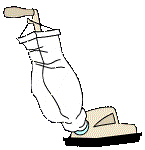The World Book Encyclopedia definition of newts is:
a small salamander that lives in water part of the time. There are various kinds of newts; all have lungs and lidded eyes, and are smooth-skinned as adults.
![]() Back to top
Back to top
 Comments re wild caught newts
Comments re wild caught newts (nb. most of this is simply repeated/adapted from the “Frogs” section)
Spring is definitely “the” season to go “Tadpole hunting”. In my area I usually head out shortly before or after the Spring Break holiday (centering on March 21) depending upon the weather. Listen to the frog songs! If the frogs are singing, then it’s getting time to head out hunting for eggs. If you don’t pay attention to the frogs themselves, you may miss getting the eggs. Of course, getting tadpoles is fine... it’s just not as exciting as seeing “your own” eggs hatch! Baby newts love to eat tadpoles and froglets, so you can count on the newts laying their eggs at about the same time as the frogs.
Before I go “tadpole hunting” I get the tanks partially set up at school (my family dreads the spring season because every ditch we drive by gets a “tadpole rating”!) I set up a small 5 1/2 gallon for the newt eggs and a 10 gallon tank for my frog eggs. Of course, if you have a 10 gallon tank available for the newts, all the better! I learned, through hard-learned experience, that baby newts (sometimes called mudpuppies) will eat up the tadpoles! Semi-adult newts will gobble up your little froglets. I use one undergravel filter (or sometimes just a corner filter). I just use gravel from the schoolyard (rinsed.) to cover the filter.
Where do you find the eggs? Look in still ponds, puddles and ditches. Undeveloped areas are the best, of course, but you do not have to venture into acres of wilderness by any means. I was lucky enough to find one seasonal “pond/puddle” (about 10 feet across) which supplied eggs until someone built a townhouse complex on it last year.
How do you recognize the eggs? If you find teeny little eggs in a mass, these might very well be newt eggs. I have not ever specifically gone looking for newt eggs, but I always seem to get some along with my frog’s eggs. The frogs often lay their eggs near the water’s edge around tall grasses or submerged sticks or logs. The eggs are in a large jelly mass. Each egg has a dark center (the tadpole) and a jelly “egg” around it. The newt eggs look similar - only smaller (about .5 smas opposed to 1 cm diameter). Try to remove the mass in one swoop of your bucket. I also have used a bleach bottle or a 4 liter plastic milk carton as a scooper. Cut off part of the side so that you have a big “scoop”, complete with handle! Be sure to collect some pond mud, water, and plants too. Toad’s eggs are in long ribbon strips (but I haven’t been lucky enough to actually see any!) Additional water (from the tap) must be conditioned properly with tropical fish “chlorine removers”. Rain water is excellent to use.
The pond plants you collect provide plenty of food during the first days of hatching. Then I switch to commercial baby fish food (it looks like a fine powder). As the tadpoles grow, I add in boiled lettuce or fresh grass and weeds from the school playground outside. (Watch out that you don’t collect from an area which has had insecticides applied.) The baby newts are much more voracious and carnivorous than the frog tadpoles. They will devour bloodworms. These can be obtained frozen from the local pet store. Thaw the worms first. Do not put in more than a half teaspoon at time, and try to “drop it” in front of the newt. Bloodworms tend to spoil the water quickly. Frozen brine shrimp and better yet, live brine shrimp, can also be obtained from the pet store. It is very beneficial to go back to your pond, or even a local ditch, to collect some more water at this time. There is lots of microscopic growth in it. Watch out though... there may be other predators lurking in the mud and weeds!
Baby newts are easy to tell from tadpoles. They have thin bodies and they grow their FRONT two legs first (instead of the back legs, like frogs). They have VERY thin legs and their large wide mouth is distinctively different from the frog tadpole’s smaller elliptical one which is under the fat head/body. Young newts gobble up bloodworms like crazy! It is really interesting to have newts... but remember... keep them in a separate tank!
If you have a good mud bottom on your tank, then you will probably hardly notice when your newts mature into adults. I usually find about 4 or 5 times more newts than I thought I had when I dump the mud back into the pond or ditch it came from. Still, if you have a light source, be SURE to have it well away from where the developing newts can reach. By the newts mature, it is probably getting close to the end of the school year. Take them back to the same pond if at all possible. They may require two or three years to be ready to reproduce, so these little guys need a safe place to grow up in! I have never tried keeping any of my little newts more than one season. It is often illegal to keep local fauna anyway. You gave them a great start, so let them go.
![]() Back to top
Back to top
 Comments re Newts purchased from the pet store.
Comments re Newts purchased from the pet store.Newts coming from the pet store are a little different matter. Generally they are provided with a typical “fish aquarium” gravel bottom. They are definitely more visible this way! It is wise to have some type of floating plant (real or artificial) so that they can come out of the water if they wish. Check with the specific instructions for your species! Be careful to chose your tank occupants wisely, or you may end up with only one pet left!
![]() Back to top
Back to top
The requirements are similar to a frog’s. The newt larvae (sometimes called “mudpuppies”) require an aquarium set-up and prefer a good layer of mud on the bottom. The eft stage (where the newts become land-dwelling) require someplace to climb out on “land”. Many newts need to return to the water for the final process of turning into an adult. If you plan to keep newts over the whole school year, you will need an aquarium tank where there is both land and a “pool” of water which is 15 to 25 cm (6” to 10”) deep. As mentioned in the “frog section”, there are some wonderful “half and half” aquarium/ terrarium setups available now, but they are very expensive. You could try building your own by silicone sealing a piece of glass to divide a “water section” from a “forest” section. You could also simply provide a plastic tub for a “pool”. The removable pool is definitely the easiest to clean. Two newts in a 5 gallon tank would be a maximum.
A screen will be needed for the top of the tank. If you have a plastic or glass over which keeps in the humidity, you will need to arrange for some way to let out excess moisture without providing an escape route! (eg. a sliding cover with holes, a screen cover etc.) Some kind of hiding place should be provided so that the newt can escape from view. Room temperature is generally sufficient, but check your species information if you have purchased an exotic species.
![]() Back to top
Back to top
The developing larvae (“mudpuppies”) will eat almost any small pond animal such as tadpoles, frog’s eggs, worms, water insects, daphnia. You can also purchase bloodworms, Tubifex worms, and brine shrimp at the pet store. In a pinch you can try small bits of lean meat or canned dog food. Be very careful to feed only small amounts at a time. All of these “meaty foods” will quickly foul your water if they are uneaten. Efts and adults eat small insects such as mosquitoes, flies, spiders, worms, and small snails. They only eat food that is moving, however. If you have problems feeding bits of meat, try dangling it on a string in front of the newt.
![]() Back to top
Back to top
 Maintenance
MaintenanceThe major maintenance involves keeping the water supply clean. Depending on whether you have one or several newts, you should replace your water every few days or at least once a week. Be sure to add the appropriate chlorine remover, just as you would for a fish aquarium. Wipe down the sides of your tank at the same time. If you are keeping your newt as a pet as opposed to a short term “visitor”, you will also need to clean out and replace the soil occasionally.
![]() Back to top
Back to top
Amphibians first developed about three to four hundred million years ago. They were a very important stage in evolution, for from amphibians came reptiles and from the reptiles came birds and mammals. There are only two basic groups of amphibians left today: those without tails, the frogs and toads, and those with tails, the salamanders (including newts). Amphibians are linked to both land and water. They are found around the world, wherever moisture is adequate and temperature is sufficient for a cold-blooded animal.
![]() Back to top
Back to top
 Characteristics
Characteristics• Newts are small creatures (8 to 15cm) with long slim bodies and long tails.
• The three part life cycle, with full metamorphosis, makes the newt an interesting subject.
• Comparisons of frog tadpoles and newt larvae show how two different species show similar, but slightly different, modes of development. Both start off as eggs, developing into quite similar “fish-like” creatures. As they develop, the differences become readily apparent in the gills, mouth shape, leg buds (tadpoles develop hind legs first, newts develop front legs first), and basic anatomy.
• The external gills are particularly showy in the larvae (“mudpuppy”) stage of a newt. These disappear and are replaced by lungs in the adult.
• A newt’s skin is always soft and moist (unlike a lizard’s skin).
• A newt’s tail can be used for grasping and is flat on both sides.
• A newt’s prey must be moving in order to attract the newt.
• Adult newts are also interesting in that they are quite active, and like to go in and out of the water.
![]() Back to top
Back to top
• Study the basic anatomy of the newt. Look for the head, eyes, nostrils, ear holes.
• Count the toes. Observe the differences between the front and hind toes.
• Describe the skin colour and texture. Compare this to a lizard’s skin.
• Compare the differences and similarities with another amphibian, such as a frog.
• Study the feeding behaviour. What kind of prey or movements attract it.
• Observe how it moves. In what order does it move its legs? Notice how the legs are thinnest where they join the body and thickest where they reach the feet.
• Observe the breathing patterns. Watch the throat movements.
![]() Back to top
Back to top
Alderton, D. 1986. A Petkeeper's guide to Reptiles and Amphibians, Salamander Books
Axelrod, Herbert R. Salamanders & Newts, N.J.: TFH Publications, 1958
Bjorn, Byron, Salamanders and Newts: A Complete Introduction, NJ: TFH Publications, 1988.
Breen, John F., Encyclopedia of Reptiles and Amphibians, NJ: TFH Publications, 1974
Obst, F.J. et al., The Completely Illustrated Atlas of Reptiles and Amphibians, NJ: TFH Publications, 1988.
Simon, Seymour, Pets in a Jar: Collecting and Caring for Small Wild Animals, Ontario: Penguin Books Canada Ltd., 1975, pp.37-43
Zimmermann, Elke, Breeding Terrarium Animals, NJ: TFH Publications.
![]() Back to top
Back to top
Amphibian Fact Sheet - general info.
http://www.acmepet.com/reptile/library/amphib.html#intr
Newt and Salamander homepage - lots of good info. and care sheets
http://www.users.interport.net/~spiff/Newt%26Salamander.html
Newts - a short but good article regarding care and handling
http://www.pathfinder.com/@@CZxgBAYAbDD0oLaz/PetPath/Exotic/Breeds/REPTAM/NEWT/NEWT.html
The Final Croak. Why are the world’s species of amphibians dying?
http://www.abc.net.au/quantum/info/q95-19-2.htm
Newtscape! A super newt site!
http://www-personal.umich.edu/~morbius/newt.html
Tapaboy Newtsite - a fun site about newts
http://www.ultranet.com/~vail/newt/
A page devoted to links to salamanders and newts! lots of them!
http://www.users.interport.net/~spiff/main/head/links.html#anchor149116
| Getting around in this Web site |
This page revised August 1998.